Dragonflies and Damselflies
# Print these PDFs double sided and flipped on the short edge.
INTRODUCTION
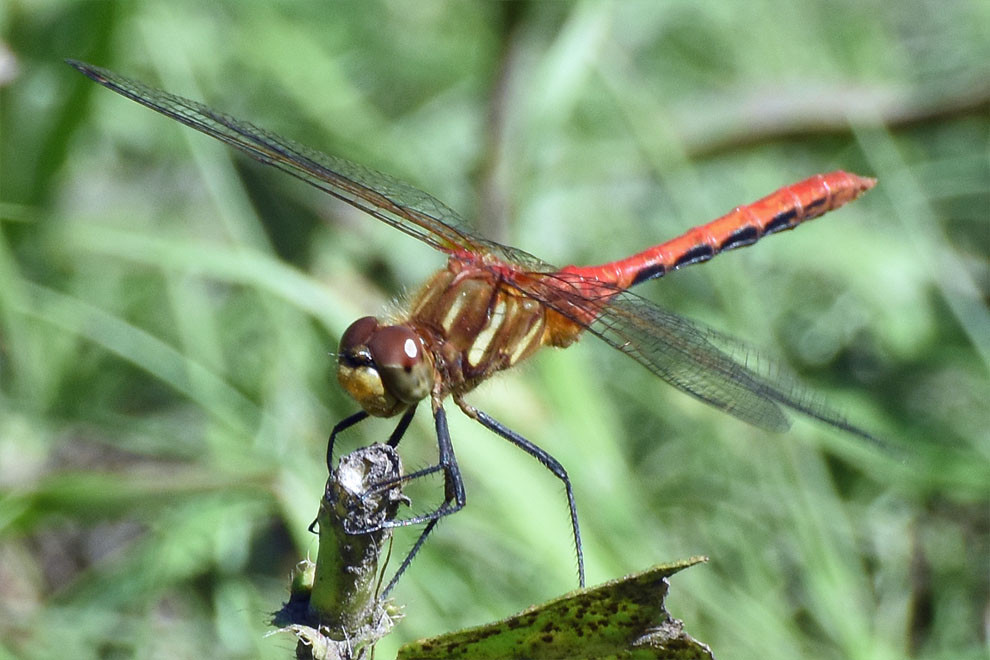
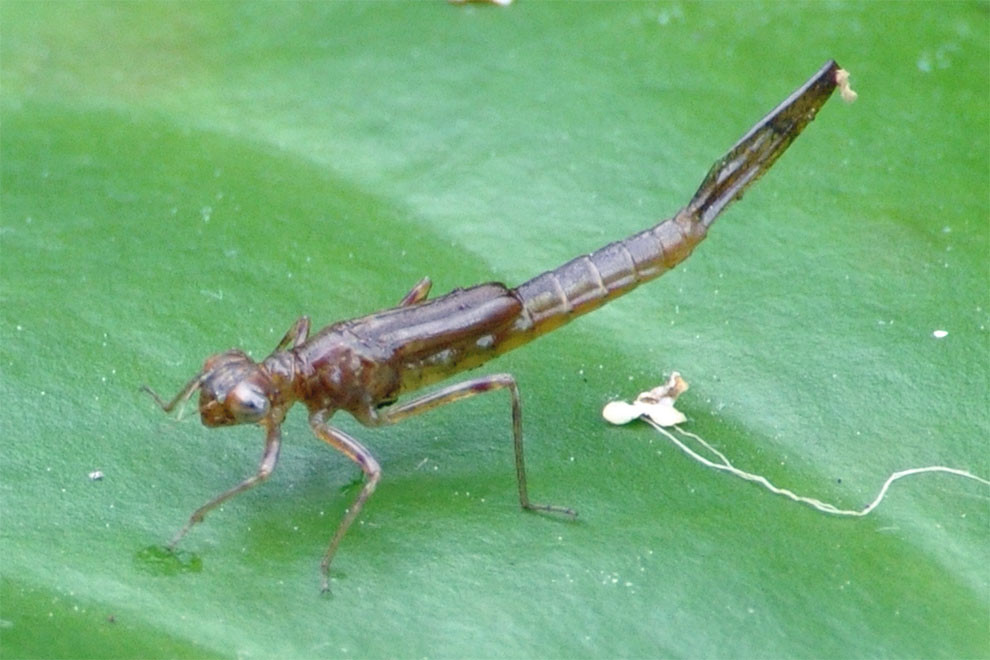
SPECIES LIST
| A | Common Name | Scientific Name | Button |
|---|---|---|---|
| DRAGONFLIES | Suborder ANISOPTERA | ||
| Skimmers | Family Libellulidae | ||
| Eight-Spotted Skimmer | Libellula forensis | ||
| Four-Spotted Skimmer | Libellula quadrimaculata | ||
| Common Whitetail | Plathemis lydia | ||
| Variegated Meadowhawk | Sympetrum corruptum | ||
| Cardinal Meadowhawk | Sympetrum illotum | ||
| Red-Veined Meadowhawk | Sympetrum madidum | ||
| Striped Meadowhawk | Sympetrum pallipes | open | |
| Autumn Meadowhawk | Sympetrum vicinum | ||
| Black Saddlebags | Tramea lacerata | ||
| Darners | Family Aeshnidae | ||
| Paddle-Tailed Darner | Aeshna palmata | ||
| Shadow Darner | Aeshna umbrosa | ||
| California Darner | Rhionaeschna californica | ||
| Blue-Eyed Darner | Rhionaeschna multicolor | ||
| DAMSELFLIES | Suborder ZYGOPTERA | ||
| Pond Damsels | Family Coenagrionidae | ||
| Western Red Damsel | Amphiagrion abbreviatum | ||
| Pacific Forktail | Ischnura cervula | open | |
| Swift Forktail | Ischnura erratica | ||
| Western Forktail | Ischnura perparva | ||
| Spreadwings | Family Lestidae | ||
| Spotted Spreadwing | Lestes congener | ||
| Northern Spreadwing | Lestes disjunctus | ||
| Emerald Spreadwing | Lestes dryas | ||
| Lyre-Tipped Spreadwing | Lestes unguiculatus | ||
Biology
TAXONOMY
The dragonflies and damselflies are insects belonging to the order Odonata, a group of insects closely related to the Mayflies (order Ephemeroptera). There are three suborders within the Odonata, the Anisoptera, the Anisozygoptera and the Zygoptera. The Anisozygoptera are a relic suborder of mostly extinct species, with only three living species found in Asia, so they will not be discussed here.
The Odonata belong to one of the oldest groups of flying insects with a fossil lineage that goes back 325 million years. One fossil species, from 300 million years ago, is the largest known flying insect with a wingspan of 70 cm. This species lived during a period of higher atmospheric oxygen levels which may have allowed its respiratory system to support such a large and active insect.
Dragonflies (Suborder Anisoptera)
Dragonflies are medium to large (30 to 70 mm long), fairly robust and often quite noticeable. Their forewings and hindwings are different shapes and are held perpendicular to the body when perched. Their eyes are close together, either touching or with a small space between.
Two families occur at Rithet's Bog, the Skimmers (Libellulidae) and the Darners (Aeshnidae). Skimmers are medium sized dragonflies that usually perch horizontally on vegetation or the ground and often return to favourite perches. Darners are large dragonflies, often with blue markings. They are usually seen flying in open areas, sometimes at a considerable distance from water. They only perch occasionally by hanging vertically from vegetation.
Damselflies, (Suborder Zygoptera)
Damselflies are small (25 to 40 mm long), slender and often inconspicuous. Their fore and hind wings are the same shape and when perched their wings are folded backward over their abdomens. Their eyes are widely spaced, protruding from the side of the head.
Two families occur at Rithet's Bog, Pond Damsels (Coenagrionidae) and Spreadwings (Lestidae). Pond Damsels perch with their wings folded completely back over their abdomens. Spreadwings perch with their wings angled backwards at 45 degrees.
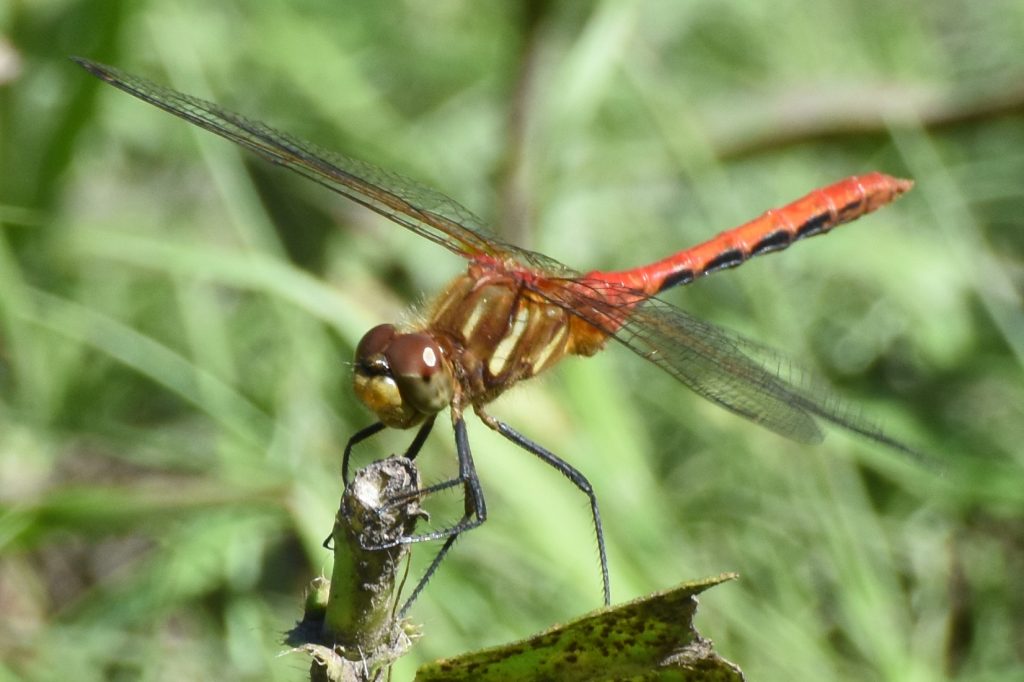
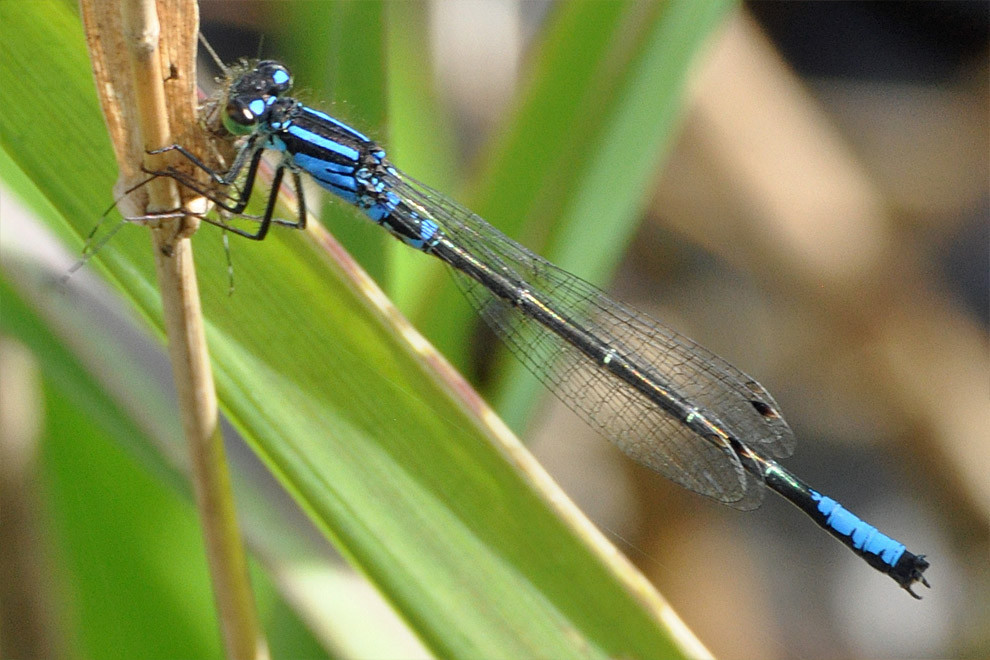
ANATOMY
This section points out some basic anatomical features useful for identifying species.
Head
- The colour of the eyes and face.
Dragonflies may have a dark horizontal line across the face. - Dragonflies may have a coloured spot where the eyes and face converge, called the vertex.
- Damselflies may have coloured postocular spots on the backs of their eyes, which may also be joined by a horizontal bar to create a dumbbell shape.
Thorax
- The colour, shape and location of stripes or spots on the sides and/or top on the thorax
- The shape and colour of the pterostigma on the wings.
- The colour patterns of the membranes and veins on the wings.
- Leg colour.
Abdomen
- The colour, shape and location of markings on the top and sides of the abdomen.
- For damselflies, the colour and markings on segments 8, 9 and 10 may be important.
- The shape of the abdominal appendages, especially for males.
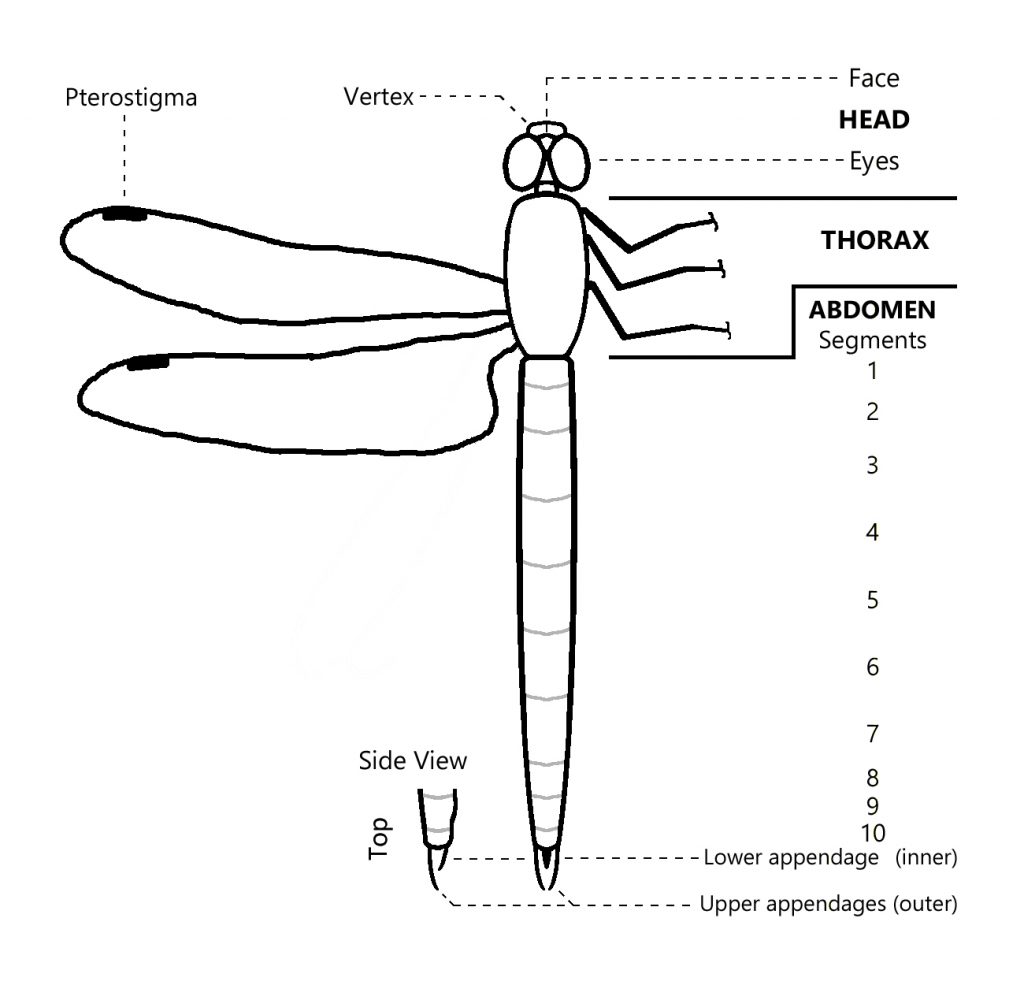
Figure 1. Dragonfly Anatomy.

LIFE CYCLE
- Tenerals are adults as they emerge from the larval exoskeleton, unfold their wings, and allow the new exoskeleton to dry. Tenerals often have subdued brown or yellowish colour patterns. This period is very vulnerable to predation and usually occurs under cover of darkness. Tenerals are easily damaged and should not be handled.
- Immatures are adults in the process of developing full adult colour patterns and reaching sexual maturity. Immatures often wander away from water to feed and complete their development.
- Mature adults, which have completed their development, return to the wetlands to breed and complete their life cycle.
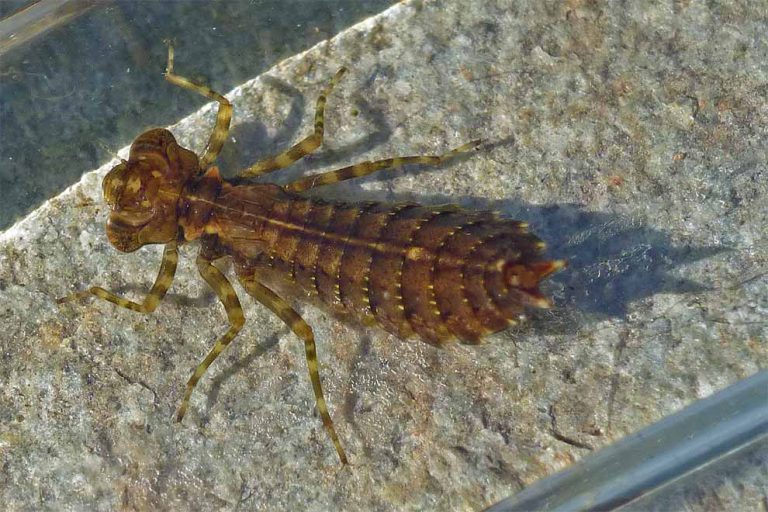
Figure 3. Dragonfly larva.

Figure 4. Damselfly larva.
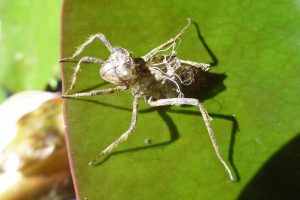
Figure 5. Dragonfly exuvium.
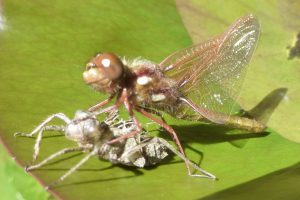
Figure 6. Dragonfly teneral
emerging and unfolding its wings.
ECOLOGY
Dragonflies and damselflies, in both their adult and larval stages, are mid level predators. Larvae prey on a wide variety of aquatic invertebrates and occasionally small fish. Adults prey on other flying insects. It turn, they provide prey for larger, higher level predators such as larger fish, amphibians and birds. As such, odonates are important indicators of biodiversity and ecological integrity in wetland ecosystems. Odonate populations reflect the state of the lower trophic levels of small predators and herbivores that they depend on. Odonate populations also support the higher trophic levels of larger predators. The International Union for Conservation of Nature (IUCN) has set up a Dragonfly Specialist Group to monitor odonate populations as indicators of the decline of wetland ecosystems.
Some species are voracious predators of mosquitoes. Adults prey on adult flying mosquitoes and larvae prey on the aquatic larvae of mosquitoes. This is an example of how healthy ecosystems with good levels of biodiversity provide us with ecological services such as natural and free pest control.
One of the benefits of having a complex, multistage life cycle with larvae and adults occupying different niches within the overall ecosystem, is that the larvae and adults do not compete for the same resources, especially food. This means the ecosystem can support larger populations than if both life stages were competing for the same resources.
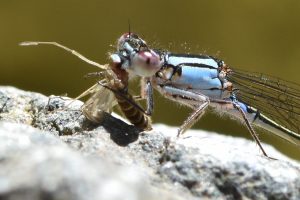
Figure 7. Pacific Forktail female eating a mosquito.
References
Unknown. 2010.
Checklist to the Dragonflies and Damselflies of
the Victoria Region. Metchosin Biodiversity
Project, Metchosin. 4 pp.
Canning, Robert A. 2007.
Dragonflies and Damselflies of Spencer’s Pond, Langford. Royal British Columbia
Museum, Victoria, BC, Canada. 9 pp.
Klinkenberg, Brian (Editor). 2015. E-Fauna BC: Electronic Atlas of the Wildlife of British Columbia. Lab for Advanced Spatial Analysis, University of British Columbia,
Vancouver, BC, Canada.
This link goes directly to the Odonata photo gallery which includes distribution maps of the species reported in BC. The complete e-Fauna BC website covers all the fauna of BC. It includes additional information about wildlife
in BC.
Paulson, Dennis R. 2009.
Dragonflies and Damselflies of the West. Princeton Field Guides. Princeton University Press, Princeton and Oxford. 535 pp.
This is the definitive field guide for the damselflies and dragonflies of western North America. Species descriptions are more detailed and cover many species that do not occur in our region. For the serious enthusiast, especially if you are travelling outside of BC.
Paulson, Dennis R. 1999.
Dragonflies of Washington. Seattle Audubon
Society, Seattle. 32 pp.
An introductory field guide for Washington State, but many of the species are also seen in BC and on Vancouver Island. No longer in print.
